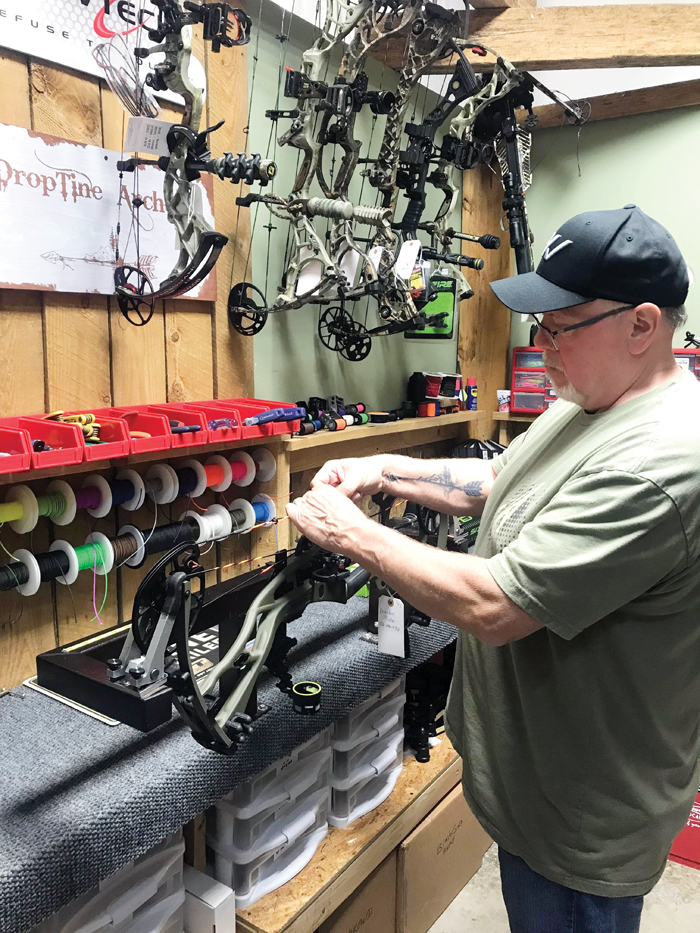Wanna step outside? Preparing archery equipment for deer season
Published 12:00 am Sunday, August 14, 2022

- Robert Brookman photo Robert Brookman of Drop Tine Archery in Advance tunes a compound bow for a bowhunter in advance of the statewide archery season opening on Sept. 10.
By Dan Kibler
North Carolina’s statewide archery season for white-tailed deer opens Sept. 10, and for the tens of thousands of hunters who take to the woods with stick and string in hand, the upcoming days will seem like the home stretch in a horse race: trying to get to the finish line from a variety of places along the track of preparation.
Depending on your level of involvement, you could be involved in some last-minute fine turning, or you could be just saddling up for the long haul. Either way, Robert Brookman of Drop Tine Archery in Advance knows what steps need to be taken, and in what order.
“Hopefully, hunters have already got their stands placed, and hopefully, they have been practicing their shooting and know what they need in terms of new strings, cables, even tuning their bows,” he said. “Your scouting should already be done; you should have your stand located so you don’t have to go back in until the season starts. Now that we have trail cameras that can send text (photos) to your phone, you don’t need to.”
But Brookman understands that not everyone has been spending six months preparing for a hot September afternoon overlooking a trail back in the woods between a soybean field and a pine thicket. So he laid out different things that hunters need to be thinking about as August starts to give way to September.
New regulations
“One thing you need to do, especially this year, is check the regulations — because of the CWD (chronic wasting disease) thing,” he said. “In the counties right around here (Davie, Forsyth, Yadkin, Surry, Stokes and parts of Wilkes, Iredell and Alleghany), baiting won’t be allowed until Sept. 1, and the state has some new regs and things to know. I know they’re going to put a freezer at our shop for hunters to drop off deer heads for (CWD sampling).”
Stand location
For hunters who’ve spent the summer fishing or doing something other than thinking about that big whitetail buck in the woods across the creek, there’s the matter of where to set up to intercept Mr. Antlers on his daily travels.
“I always look for food sources,” Brookman said. “That dictates where they are going to be. If animals could hunt us, they’d be set up at the restaurants, because that’s where we’ll be.
“Does will be on food, and bachelor groups of bucks will be on food. You want to try and set up between the food source and a bedding area.”
Brookman said that wind direction plays the biggest role in deciding the exact tree that should hold your stand — lock-on, climber, ladder, whatever.
“The wind direction is key,” he said. “In the fall, our predominant wind is primarily from the northwest. We might get a little northeast every now and then, but you need to set up for a northwest wind.”
That means locating your stand to the southeastern side of any major deer thoroughfare you want to watch, so the wind will be blowing into your face; the deer moving past upwind will have less chance of catching your scent.
“And make sure you have trimmed limbs from around your stand and cleaned out shooting lanes,” Brookman said.
Equipment
If you’re just starting to practice shooting, make sure your bow is in good shape. Does the string look frayed? Any of the cables making noise? Are you shooting different arrows or broadheads from previous seasons?
“If your bow is tuned, it should shoot broadheads and field points the same way,” Brookman said. “Also, make sure all the clothes you’re going to wear hunting have been washed in something like ElimiShield that kills your odor. Two things you can’t have in your stand are movement or odor.
“Make sure you have all your equipment ready: binos (binoculars), range finder, safety harness — everything you need.”
Practice, practice, practice
Make sure you’re slinging arrows at a target every day. If you don’t have time, make time for at least a handful of shots.
“You should have been practicing for months, but 90% of hunters don’t,” Brookman said. “You should be shooting at least 15 minutes a day. If you only shoot 20 arrows a day, you’ll still build up your muscle memory and be OK.
“But when you shoot, don’t shoot in flip-flops and shorts. Shoot in the clothes you’ll be hunting in. If you wear gloves, practice in gloves. And shoot from your stand, even if you only put it a couple of feet off the ground. You need to practice from the platform you’ll be shooting from. Get acclimated to what you’re standing on.”





